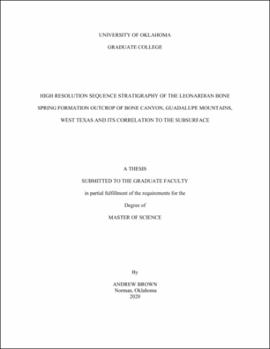| dc.contributor.advisor | Pigott, John | |
| dc.contributor.author | Brown, Andrew | |
| dc.date.accessioned | 2020-05-12T13:43:58Z | |
| dc.date.available | 2020-05-12T13:43:58Z | |
| dc.date.issued | 2020-05 | |
| dc.identifier.uri | https://hdl.handle.net/11244/324395 | |
| dc.description.abstract | The purpose of this Thesis is to analyze the Upper Leonardian Bone Spring Formation, Cutoff Formation, and Early Guadalupian Brushy Canyon Formation in the outcrop of Bone Canyon located along the Western Escarpment of the Guadalupe Mountains in West Texas. The stratigraphy in Bone Canyon reveals numerous sea-level fluctuations that influenced the depositional processes and paleo-environments. By analyzing the outcrop, new data was obtained of lateral variations in the strata through in-depth field and laboratory analysis, including XRF and petrographic analysis. This data provides insight into the lithology and diagenetic processes impacting reservoir characterization that could only be obtained through outcrop analysis. Lateral studies provide a detailed look into various depositional processes that occurred within the same sea level sequence and show the importance of understanding lateral (dis)continuity, erosion, and deposition that transcend both chrono- and stratigraphic boundaries previously defined in the stratigraphy.
The high-resolution study shows similar elemental concentrations in the strata despite variations in sea level between strata. The study seems to indicate that chert formation and dolomite concentrations were sometimes affected by depositional processes independently of sea level fluctuations. TSTs-HSTs reveal alternating beds of carbonate and post-diagenetic chert, RSTs-LSTs reveal nodular-mottled chert formation along with mass transport deposits, which are also seen during TSTs. These mass transport deposits provided the rapid burial and compaction processes necessary for dolomitization to occur during lowstands in sea level.
According to this analysis, evidence illustrates that the Avalon deposit, which has been recognized to be comprised of the Bone Spring and Cutoff Formation, is much thicker near the slope-basin transition zone at this location than it is on the shelf and in the basin as many subsurface studies have suggested. Outcrop analysis allows a more detailed look into the Avalon sequences than can be seen in the subsurface. The Avalon Shale is shown to cross chronostratigraphic boundaries, which originates from the L5 HFS of the Bone Spring Formation and ends at the G1 HFS of the Cutoff Formation. The alternation between high terrigeneous and carbonate concentrations in these Avalon deposits is interpreted as the result of the effects of lowstands and highstands in sea levels, which turned out providing finer-scale observations into the depositional environments and processes. The elemental and XRF analyses of this study are used as paleoenvironment proxies that aid in revealing the ideal source and reservoir rocks potential in these deposits during the fluctuations in sea level. Furthermore, results also suggested that during transgressive system tracts, pervasive permeable gravity debris flows could deposit in a more anoxic environment that resulted in a higher potential for hydrocarbon generation. | en_US |
| dc.language | en_US | en_US |
| dc.subject | Geology. | en_US |
| dc.subject | Geochemistry. | en_US |
| dc.subject | Geophysics. | en_US |
| dc.subject | Bone Spring Sequence Stratigraphy | en_US |
| dc.subject | Avalon Complex Sequence Stratigraphy | en_US |
| dc.subject | Cutoff Formation stratigraphy | en_US |
| dc.subject | Delaware Basin Sequence Stratigraphy | en_US |
| dc.title | High Resolution Sequence Stratigraphy of the Leonardian Bone Spring Formation Outcrop of Bone Canyon, Guadalupe Mountains, West Texas and its Correlation to the Subsurface | en_US |
| dc.contributor.committeeMember | Elmore, R. Douglas | |
| dc.contributor.committeeMember | Pigott, Kulwadee | |
| dc.date.manuscript | 2020-05 | |
| dc.thesis.degree | Master of Science | en_US |
| ou.group | Mewbourne College of Earth and Energy::School of Geosciences | en_US |
| shareok.orcid | https://orcid.org/0000-0001-5287-5990 | en_US |
